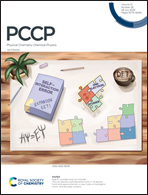Evaporation of Ar/Kr mixtures on platinum surface: a molecular dynamics study†
Abstract
Evaporation is a typical heat and mass transfer process, which is important in both nature and industry. Here, the evaporation of five fluid samples (pure Ar, pure Kr and Ar/Kr mixtures with molar ratio Ar : Kr = 1 : 3, Ar : Kr = 1 : 1 and Ar : Kr = 3 : 1) on Pt surface was investigated using molecular dynamics simulations. Colligative properties of the mixtures led to the melting of the Ar/Kr mixtures (Ar : Kr = 1 : 1, Ar : Kr = 3 : 1) at 70 K below the triple point of Ar. Furthermore, under the same condition, the other systems were frozen as the solid state. The Pt surface at 90 K, over the boiling point of Ar, triggered the evaporation of Ar atoms in all the systems while the Kr atoms remained in the condensed state. Kr atoms were reported to be evaporated to a large extent when the Pt surface was heated to 120 K near the boiling point of Kr. The presence of Kr could reduce the evaporation of the Ar atoms, especially when the mole ratio of Ar : Kr in the mixture was 1 : 1 because the Ar : Kr = 1 : 1 system can effectively reduce the temperature of the gas–liquid interface. The temperature of the fluid samples then decreased with increase in distance between Pt and fluid atoms because the evaporated atoms could take the thermal energy away from the condensed films. Moreover, both Ar and Kr atoms, which were close to the Pt surface, hardly changed during evaporation because of the strong attractive force from the Pt substrate.



 Please wait while we load your content...
Please wait while we load your content...